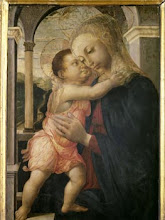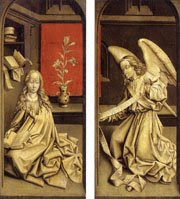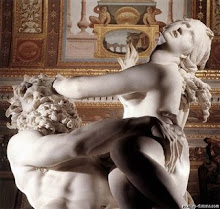skip to main |
skip to sidebar



BABUREN, Dirck van
(b. ca. 1590, Utrecht, d. 1624, Utrecht)
Biography
Dutch painter (original name Theodor Baburen) who was a leading member of the Utrecht school, which was influenced by the dramatic chiaroscuro style of the Italian painter Caravaggio.
After studying painting with a portraitist and history painter in Utrecht, Baburen traveled to Rome about 1612. His most important Italian commission was the decoration of a chapel in the Church of San Pietro in Montorio, Rome (1615-20), which included his Entombment (1617).
In 1620 Baburen returned to Utrecht, where he shared a studio with Hendrick Terbrugghen in about 1622-23. The influence of Caravaggio may be seen in his Christ Crowned with Thorns (two versions, at the Franciscan House, Weert, Netherlands, and at Drury-Lowe Collection, Locko Park, England), based on a lost painting by the master. Baburen was especially fond of genre scenes (subjects from everyday life), such as The Procuress (1622; Museum of Fine Arts, Boston). A certain coarseness in conception, irregular compositional rhythms, and less atmospheric quality distinguish Baburen's art from that of his greater contemporaries, but his manner of painting can be said to be broad and forceful.








ANTOLINEZ, José
(b. 1635, Madrid, d. 1675, Madrid)
Biography
Spanish painter active in Madrid, where he was the equivalent of Murillo in Seville. In his genre scenes the influence of Velázquez, as well as that of Murillo, is evident - e.g. The Picture Seller (Munich) - but his style derives from the Venetians and from Rubens. He specialized in the typically Spanish subject of the Immaculate Conception, of which at least twenty-five versions by him are known. He also painted portraits. There are works in Amsterdam, Barnard Castle (Bowes Museum), Copenhagen, Dublin, Madrid, Oxford (Ashmolean) and Seville.







AMIGONI, Jacopo
(b. 1682, Napoli, d. 1752, Madrid)
Biography
Jacopo Amigoni (Amiconi) was a Venetian history and portrait painter who worked all over Europe in a more or less international style, the Venetian Rococo, with elements compounded from Sebastiano Ricci and French Rococo, and, later, Tiepolo. He worked for some years for the Elector of Bavaria and then came to London in 1730, where he painted several decorative cycles (e.g. Rickmansworth, near London, Moor Park Golf Club) and portraits; though these, according to Vertue, were 'not his inclination - nor Talent'. In 1739 he returned to Venice with a small fortune, and it was he who persuaded Canaletto to visit London (1746). In 1747 he went to Madrid as Court painter: Vertue records that news of his death there reached London just as his finest works - in St James's Square - were destroyed. The altarpiece of Emmanuel Collection, Cambridge, is his; other works are in Darmstadt, London, Madrid, Venice and York.




ANGELI, Giuseppe
(b. 1712, Venezia, d. 1798, Venezia)
Biography
Late Baroque Italian painter, active mainly in Venice. He entered Piazzetta's workshop at an early age. Among the painters of the workshop he was the most adept at imitating the master's style, and later he became the director of the workshop. In his early period he produced genre paintings, half-length devotional images, decorative cycles, and large religious paintings, however, in his maturity he concentrated on religious paintings. His style derived primarily from his teacher's late manner, although he was receptive to other contemporary developments, particularly the refined elegance and lighter palettes of Giovanni Battista Tiepolo and Jacopo Amigoni.
In addition to large altarpieces, Angeli also executed decorative commissions in palaces and villas. He is known for two canvases in the church of San Stae and for a series of frescoes at the Villa Widmann-Foscari near Padua. He was repeatedly employed by the Scuola di San Rocco, where he executed a number of ceiling paintings and restored works by Jacopo Tintoretto.
Elected drawing master in 1756, Angeli was long a leading member of the Venetian Academy until the later 1770s.


ALTOMONTE, Martino
(b. 1657, Napoli, d. 1745, Wien)
Biography
Painter, part of an Austrian family of artists. Martino Altomonte was the son of Michael Hohenberg, a baker who had emigrated from the Tyrol to Naples, and it was Martino who changed the family name to its Italian form in 1684. Martino and his son Bartolomeo Altomonte (1694-1783) both became celebrated for their decorative paintings in Austria, which continued the traditions of the Viennese school of late Baroque fresco. Of Martino's other sons, Franz Lorenz Altomonte (c. 1693-1765), an engraver, studied under Antonio Maria Gennaro (1679-1744) in Vienna. From 1727 he worked as an engraver at the Mint in Prague. Examples of his work can be found in the Kunsthistorisches Museum, Vienna. Andreas [Andrea] Altomonte (1699-1780), an architect, studied at the Akademie der Bildenden Künste in Vienna from 1726 to 1728. Another possible family member, Giacomo Altomonte (first half of the 18th century), was presumably related to Martino Altomonte as there is a painting by him at St Florian Abbey. He also produced frescoes and paintings for the churches of S Antonio (1721) and S Domenico (1722), both in Cagliari.
Martino Altomonte (Johann Martin Hohenberg) was apprenticed at the age of 15 to Baciccio (Giovanni Battista Gaulli) in Rome, where he next studied with Carlo Maratti. In 1684 he was offered an appointment at the court of King John III of Poland and altered his name to Martino Altomonte. He travelled to Warsaw, where he produced paintings of royal battles and portraits (untraced) for the royal castle of Zólkiew (now Nesterov) near Lwow (now Lviv, Ukraine). It appears that he also painted a fair number of altarpieces. Of these, only the Sacrifice of Abraham (now Tarnów, Diocese Museum) survives, a work that reveals Altomonte as a follower of Neapolitan chiaroscuro painting.
Between 1699 and 1702 Altomonte moved to Vienna, where he became a teaching member of the Akademie der Bildenden Künste in 1707. It was probably in connection with his admission to the Akademie that he was commissioned to decorate the Neue Favorita, an annexe of Schloss Augarten. The few surviving oil paintings from this period, for example Susanna and the Elders (1709; Vienna, Belvedere), show the strong impact of the Neapolitan painting of Luca Giordano and suggest Venetian influence as well. Altomonte developed a mixed Neapolitan-Venetian style that incorporated the illusionistic architecture of Andrea Pozzo and created a style that set the standard for Viennese Baroque painting. In his oil paintings he scattered Venetian pastel tones among dramatic elements of Neapolitan chiaroscuro.
In 1709-10 he worked on ceiling paintings for the archbishop's Residenz at Salzburg, and about 1710 he became imperial court painter. He also produced altar paintings in Vienna for the Dorotheerkirche (1713; now in Rheindorfer Parish Church), the Peterskirche and the Stephansdom (both 1714) and for the parish church in Krems and the Deutschordenskirche in Laibach (now Ljubljana, Slovenia; both 1715). In 1716 he painted the ceiling frescoes in the Lower Belvedere in Vienna. ALTOMONTE, Martino

ALLORI, Cristofano
(b. 1577, Firenze, d. 1621, Firenze)
Biography
Alessandro Allori (1535-1607), Florentine painter, the pupil and adopted son of Bronzino. An early visit to Rome added the influence of late Michelangelo paintings to that of his master's courtly Mannerism. The Pearl Fishers (Studiolo of Francesco I, Palazzo Vecchio, Florence, c.1570) is generally considered his masterpiece; playful and full of artifice, it combines nude figures obviously drawn from Michelangelo with Bronzino's svelteness and enamelled colouring. He was one of the last notable exponents of Mannerism, painting in a style that had become outmoded by the time of his death.
His son Cristofano (1577-1621) was one of the leading Florentine painters of his period, working in a style that was more naturalistic and Baroque than that of his father. He is remembered primarily for one work, Judith with the Head of Holofernes (c. 1615, Pitti, Florence, and other versions), in which his femme fatale mistress is portrayed as Judith and he has depicted his own features in Holofernes' severed head. In the 18th and 19th centuries it was one of the most famous paintings in Italy. The Ashmolean Museum in Oxford possesses portraits by both Alessandro and Cristofano Allori.










ALBANI, Francesco
(b. 1578, Bologna, d. 1660, Bologna)
Biography
Albani studied in Bologna with the Mannerist Denijs Calvaert before joining the Carracci Academy where he was an enthusiastic pupil. Like so many other artists from Bologna, he moved to Rome to study classical art which he then applied with zeal to his own work. Albani's classicism can be seen in the altarpieces he painted after returning to Bologna. Among them is The Baptism of Christ now in the Bologna Pinacoteca Nazionale.
His love of classical antiquity is still more evident in the cycles he painted on mythological subjects, a genre of painting he practically established. He used mythology in Dance of the Amorini or the allegorical tradition (elements, seasons) as the pretext to paint smiling idylls to which he added nymphs, goddesses, and happy little putti all set against luminous ideal landscapes. In this way he created an appetite for light-hearted, pleasant works which lasted throughout the seventeenth century. It did, however, tend at times to decline into insipidity. His favourite format for this type of composition was the tondo or oval.








This page deals with baroque sculptures following the same pattern: they are funeral monuments, usually on the side walls of chapels and they show the dead in the act of praying behind a kneeling-stool.Here below a famous example of these sculptures in Cappella Cornaro in S. Maria della Vittoria, where Gian Lorenzo Bernini portrayed the members of the Cornaro family.
Cappella Cornaro in S. Maria della VittoriaBusts in the act of praying became quite common in the XVIIth century in many European countries. The change towards showing not much more than the bust of the dead, but behind a kneeling-stool (or just behind the top of it), was introduced by Alessando Algardi in his Monument to Cardinal Garcia Millini in S. Maria del Popolo.
Monument to Cardinal Garcia Millini (1638) by Alessandro Algardi in S. Maria del Popolo and Monument to Virginia Primi Bonanni (1648) by Giuliano Finelli in S. Caterina da Siena a MagnanapoliAlgardi did not sculpt the kneeling-stool, but in seeing the statue we get the impression that it is a full body statue of which we see only the upper part. The cardinal is shown with his prayer book and in the act of beating (gently) his breast. The idea suggested by this monument was immediately developed in a clearer way, usually by sculpting a cushion before the bust: you can see this in a monument by Giuliano Finelli in S. Caterina da Siena a Magnanapoli. Finelli who started his career with Gian Lorenzo Bernini, ended it by adhering to the recommendations of the Accademia di S. Luca for "classical" art. Gian Lorenzo Bernini made use of this kind of sculptures in designing Cappella Raimondi in S. Pietro in Montorio and Cappella Cornaro in S. Maria della Vittoria.
Monument to Gabriele Fonseca (1661) by Gian Lorenzo Bernini in S. Lorenzo in Lucina, Monument to Johannes Savenier (1638) by Alessandro Algardi and Monument to Gualtiero Gualteri de Castro (1659) by Ercole Ferrata in S. Maria dell'AnimaBernini sculpted personally the Monument to Gabriele Fonseca, a wealthy Portuguese doctor, in S. Lorenzo in Lucina. It is a portrait full of life, typical of Bernini's sculpture. In the church of S. Maria dell'Anima we can compare a work by Alessandro Algardi, the leader of the classical school, with a work by Ercole Ferrata, one of Bernini's best scholars. The intense devotion of the young man, represented in a very classical way, (left/Algardi) makes somewhat melodramatic the attitude of the cardinal (right/Ferrata).In some monuments in large chapels or in the naves of the church we see a full body sculpture or to be more precise a full body high relief. The monument to Cardinal Pimentel in S. Maria sopra Minerva was designed by Gian Lorenzo Bernini and executed by his scholars. This position of the dead will show up again in Bernini's Monument to Alexander VII.
Monument (left) to Cardinal Domenico Pimentel (1654) sculpted by Ercole Ferrata and designed by Gian Lorenzo Bernini in S. Maria sopra Minerva; Monument (middle) to Cardinal Marzio Ginetti (1675) by Antonio Raggi in S. Andrea della Valle and Monument (right) to Archbishop Carlo di Montecatini (1699) by Domenico Guidi in S. Maria in AquiroAs in many other cases the themes and ideas suggested by Bernini were used by other architects and sculptors. Carlo Fontana designed the Ginetti Chapel in S. Andrea della Valle and he asked Antonio Raggi, a scholar of Bernini, to portray Cardinal Ginetti in a position very similar to that of Cardinal Pimentel. Domenico Guidi is one of the few sculptors of the XVIIth century who did not work for Bernini. He was the preferred pupil of Alessandro Algardi and at his death he inherited his "customers". For many years he had a very busy workshop as he offered his services at a very competitive price. A monument by him can be seen in S. Maria in Aquiro.In the church of Gesù e Maria the funeral monuments of the family Bolognetti are in the nave. Giorgio Bolognetti, bishop of Rieti, had contributed to such an extent to the cost of the decoration of the church that he was allowed to erect the funeral monuments for his family in the nave: for this reason the church was also called il Cappellone (the large chapel).
Monument to Ercole e Giovan Luigi Bolognetti (1686) by Lorenzo Ottoni in Chiesa di Gesù e MariaThe distance from the altar, however, impacts on the effect of the monuments and the relatives of Monsignor Bolognetti, seem more involved in social talks between themselves, than intent on praying. The monument is by Lorenzo Ottoni a scholar of Ercole Ferrata, whose works can be found in many towns of the papal state. In general he showed strict links with Bernini's school, but he was also influenced by the growing relevance of French artists and more in general of France on Roman society, as we can see in another monument in the little church of S. Maria in Publicolis.
Monument to Marquis Antonio Publicola Santacroce and his wife Girolama Nari (1709) by Lorenzo Ottoni in S. Maria in PublicolisThe church was a sort of family chapel of Marquis Santacroce, who lived nearby. As we can see he dressed in the French way and wore a wig. While the marchioness is portrayed in a very stiff attitude, the marquis beats his breast like the cardinals of Algardi and Ferrata.The XVIIIth century was a very disenchanted time, even in Rome. Acts of contrition were no longer popular and the rich were more interested in minuets. This showed up also in funeral monuments.
Monuments to Giovanni Andrea Giuseppe Muti and Maria Colomba Vincentini Muti (1725) by Bernardino Cametti in S. MarcelloGiovanni Andrea Muti and his wife had a palace near SS. Venanzio e Ansovino, but they preferred to buy a chapel in the more fashionable church of S. Marcello al Corso. The monuments designed for the Muti by Bernardini Cametti are formally very similar to those built in the XVIIth century, but the spirit is different. The viewer has the impression that the husband is inviting his coy wife to dance. In general the Baroque period in Rome is considered ended by 1750, so Paolo Posi who worked in Rome mainly after 1750 is not mentioned in many books and essays about Baroque Rome: he designed however some funeral monuments which for the use of color and different materials belong to the baroque tradition: in particular his monument to Maria Flaminia Odescalchi Chigi in 1771 can be regarded as the last baroque tomb in Rome.
Monument to Cardinal Pier Luigi Carafa (1759) by Paolo Posi and Pietro Bracci in S. Andrea delle FrattePaolo Posi was not a sculptor, but rather a particular kind of architect in the sense that he designed ephemeral architectures for celebrations. The monument to Cardinal Carafa in S. Andrea delle Fratte was designed by him but the statue of the cardinal was sculpted by Pietro Bracci. Other pages dealing with Baroque sculpture:Monuments showing the dead in a medallionRepresentation of Death in Baroque sculpturesBaroque AngelsThree chapels by Gian Lorenzo BerniniThree busts by Alessandro AlgardiBaroque Monuments to the PopesBaroque High ReliefsStatues Close to HeavenEmbittered Andrew (the statues in St. Peter's octagon)Laughing MasksPlaying with Colours

















































































.jpg)


.jpg)











